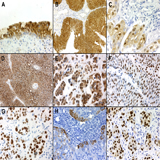
John PT Higgins, Gulsah Kaygusuz, Lingli Wang, Kelli Montgomery, Veronica Mason, Shirley X Zhu, Robert J Marinelli, Joseph C Presti Jr, Matt van de Rijn, James D Brooks
| Home |
|
Home |
| Images |
|
View the Bladder tissue array images |
| Figures and Tables |
|
View or download Figures and Tables |
| WebPortal |
|
Stanford Tissue Microarray Consortium Web Portal |
| Authors |
|
Authors |
| HOME |
|
Welcome to the web supplement to the paper: Placental S100 (S100P) and GATA3: Markers for Transitional Epithelium and Urothelial Carcinoma Discovered by Complementary DNA Microarray American Journal of Surgical Pathology, May 2007, 31:5 Abstract The morphologic distinction between prostate and urothelial carcinoma can be difficult. To identify novel diagnostic markers that may aid in the differential diagnosis of prostate versus urothelial carcinoma, we analyzed expression patterns in prostate and bladder cancer tissues using complementary DNA microarrays. Together with our prior studies on renal neoplasms and normal kidney, these studies suggested that the gene for placental S100 (S100P) is specifically expressed in benign and malignant urothelial cells. Using tissue microarrays, a polyclonal antiserum against S100P protein stained 86% of 295 urothelial carcinomas while only 3% of 260 prostatic adenocarcinomas and 1% of 133 renal cell carcinomas stained. A commercially available monoclonal antibody against S100P stained 78% of 300 urothelial carcinomas while only 2% of 256 prostatic adenocarcinomas and none of 137 renal cell carcinomas stained. A second gene, GATA3, also showed high level expression in urothelial tumors by cDNA array. A commercially available monoclonal antibody against GATA3 stained 67% of 308 urothelial carcinomas, but none of the prostate or renal carcinomas. For comparison, staining was also performed for p63 and cytokeratin 5/6. p63 stained 87% of urothelial carcinomas whereas CK5/6 stained 54%. Importantly, when S100P and p63 were combined 95% of urothelial carcinomas were labeled by one or both markers. We conclude that the detection of S100P and GATA3 protein expression may help distinguish urothelial carcinomas from other genitourinary neoplasms that enter into the differential diagnosis. |